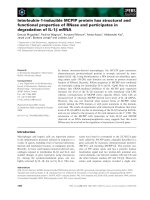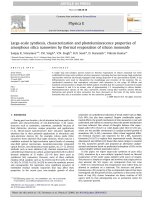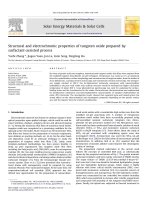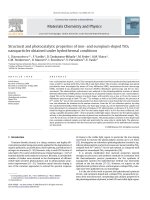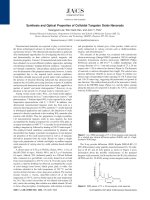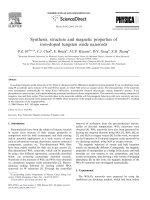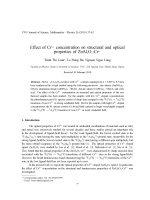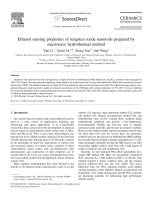- Trang chủ >>
- Khoa Học Tự Nhiên >>
- Vật lý
structural and electrochromic properties of tungsten oxide prepared by surfactant-assisted process
Bạn đang xem bản rút gọn của tài liệu. Xem và tải ngay bản đầy đủ của tài liệu tại đây (670.26 KB, 7 trang )
Structural and electrochromic properties of tungsten oxide prepared by
surfactant-assisted process
Yuzhi Zhang
Ã
, Jiaguo Yuan, Jun Le, Lixin Song, Xingfang Hu
The Key Laboratory of Inorganic Coating Materials, Shanghai Institute of Ceramics, Chinese Academy of Sciences (CAS), 1295 Dingxi Road, Shanghai 200050, China
article info
Article history:
Received 30 June 2008
Received in revised form
18 January 2009
Accepted 6 February 2009
Available online 25 March 2009
Keywords:
Nanostructured
Electrochromic
Tungsten oxide
abstract
By virtue of gemini surfactant template, nanostructured tungsten oxides thin films were prepared from
the modified tungsten hexachloride sol–gel techniques. Temperature was varied as it is an important
factor for crystallization, surface morphology and microstructure of tungsten oxides, from the s tudies of
X-ray diffractions, scanning electron microscopy and transmission electron microscopy. The mesopor-
ous sample calcined at 300 1C has tri-dimensional vermicular mesop ores with nanocrystallites
embedded in the pore wall, while such uniform structure would be destroyed by higher calcination
temperature of about 400 1C. X-ray photoelectron spectroscopy was used for analyzing the surface-
binding states and the stoichiometry for the oxides. Electrochromic characterization was implemented
by simultaneous voltametric and spectrophotometric measurements of tungsten oxides/indium tin
oxide (ITO) electrodes. The investigation results showed that organized pore-wall nanostructure has
strong effects on the electrochemical and chromogenic properties depending on the specific surface
area and the impacts from the evolved crystallization.
& 2009 Elsevier B.V. All rights reserved.
1. Introduction
Electrochromic material was known to undergo change in their
optical properties upon applied voltages, which could be used for
smart windows, displays, antiglare mirrors and advanced glazing
[1–3]. Among the numerous thin films of transition metal oxides,
tungsten oxide was recognized as a promising candidate for the
optically active electrodes. Much research on electrochromic WO
3
thin films was based on the preparation of vacuum evaporation,
laser ablation or sputting methods, etc. [4–6]. On the other hand,
wet deposition could be an alternate technique to study the
preparation of tungsten oxide thin films [7,8]. Lately, some
template-mediated methodology has been proven feasible to
bring up pore organization into tungsten oxide thin films
including the Poly(acrylic acid) (PAA)/WO
3
route for microporous
coatings [9], the two-step molding process using porous anodic
alumina and poly(methyl methacrylate) (PMMA) templates [10]
and electrochemical deposition containing sodium dodecyl sulfate
surfactant template [11]. From the tetraisopropyl titanate pre-
cursors system, Zhao et al. [12] have presented that nanostruc-
tured titania with mesoporosity could be prepared by using
nonionic Pluronic P123 surfactant template. At the same time, the
evaporation-induced self assembly (EISA) approach has also
offered new opportunities for the preparation of nanoarchitec-
tured metal oxides with a considerable high surface area from the
modified sol–gel processing [13]. A number of mesoporous
transition metal oxides have been successfully prepared using
self-assembled nonionic surfactants templates into chloro-
alkoxide sol–gel precursors systems [14–16]. Mesoporous vana-
dium oxide has been synthesized from ethanolic solution of metal
chlorides (VOCl
3
or VCl
4
) and monomeric nonionic surfactant
Brij56 or Brij58 templates [17]. Some efforts about the study of
WCl
6
sol–gel associated with complexing agents were also
investigated [18,19]. Acetylacetone was used into WCl
6
sol–gel
by Bechinger et al. [20] for the fabrication of microcontact-printed
nanostructure. In addition, Bell et al. [21] reported that the
introduction of epoxide additive could improve the chromogenic
quality of coatings.
The preparation method undertaken in the current work
follows the concepts of controlled EISA [22], as schematically
shown by the proposed mechanism of Fig. 1. The gemini nonionic
surfactant template used here mainly consisted of TMDD micella.
The major feature of TMDD (2,4,7,9-tetra-methyl-5-decyn-4,7-
diol) was that it has two dendritic branched hydrophobic groups
and two hydrophilic hydroxyl groups, which makes it highly
efficient with lower critical micelle concentration (CMC) com-
pared with monomeric surfactant [23]. For essential concern of
homogeneousness and transparency, the full hydrolysis-conden-
sation was constrained by one controlled low relative humidity
(RH), which was permitted to increase after volatile evaporations
and cooperative self-assembly of the tungsten-oxo/TMDD meso-
phase. Finally, the hybrid was subjected to thermal treatment to
ARTICLE IN PRESS
Contents lists available at ScienceDirect
journal homepage: www.elsevier.com/locate/solmat
Solar Energy Materials & Solar Cells
0927-0248/$ -see front matter & 2009 Elsevier B.V. All rights reserved.
doi:10.1016/j.solmat.2009.02.016
Ã
Corresponding author. Tel.: +86 2152412359; fax: +86 2152414993.
E-mail addresses: (Y. Zhang), (J. Yuan).
Solar Energy Materials & Solar Cells 93 (2009) 1338–1344
remove the organic template and build pore-wall framework
mesostructuation.
The scope of this paper was centred on the characterization of
microstructural and electrochromic properties of the nanostruc-
tured tungsten oxides with mesopores from the TMDD surfactant-
assisted process. The crystallization status, surface morphology
and microstructure characteristics of the materials were investi-
gated with X-ray diffractions (XRD), scanning electron microscopy
(SEM) and transmission electron microscopy (TEM), respectively.
The surface-binding states and stoichiometry of the films were
studied by X-ray photoelectron spectroscopy (XPS).
Moreover, the influence of nanostructure upon electrochromic
behaviours for tungsten oxide thin films was discussed. The
principle that was found was that mesopores organization
has strong effects on the electrochemical and chromogenic
performance of tungsten oxide thin films. Compared with the
non-templated sample, the nanostructured oxide with a higher
specific surface area has better electrochromic response and
dynamic optical quality. On the other hand, more evolved
crystallization of the monoclinic phase would have impacts to
destroy this nanostructured pore-wall organization and induce
inferior properties.
2. Experimental
2.1. Preparation of tungsten oxide thin films
Primarily, all chemical reagents are commercially available. As
a consequence, the preparation process of mesoporous tungsten
oxides was reported as described elsewhere [24]. Briefly, a certain
amount of TMDD C
14
H
24
EO
20
(HO(EO)
x
C
14
(EO)
y
OH, Mw $1250,
AR, Aldrich) was dissolved in 10 ml of ethanol (C
2
H
5
OH, AR 99.5%,
SCRC Co.) to form the surfactant template solution. Then 1 g of
anhydrous tungsten hexachloride (WC1
6
, 99.9%, Aldrich) was
slowly added into this solution. After stirring for further 2 h at
room temperature in air, the precursor was aged at 40 1C for about
24 h to prepare the coating solution. Mesoporous tungsten oxides
were coated onto substrates in a chamber under a controlled low
relative humidity of about 30–50% at room temperature, followed
by drying at 120 1C in an oven for 1 h to evaporate the solvents
and to consolidate the network of the self-assembled hybrid.
Hereafter, the as-dried films were exposed to the other controlled
high RH of 80–10 0% for about 1 min to force the extended
hydrolysis–condensation and obtain the as-synthesized samples.
When electrochemical electrodes were fabricated, the tungsten
oxides thin films were dip-coated onto indium tin oxide (ITO)
coated conducting transparent glass with a sheet resistance of
10
O
/&. Finally, the as-synthesized sample (named as sample B
with thickness about 240 nm) was subjected to a series of
temperatures in air at a ramp of 2 1C/min and calcined for 2 h,
where sample C was named for 300 1C with a thickness of about
200 nm and sample D for 400 1C with a thickness of about 180 nm.
Additionally, besides the mesoporous samples, non-templated
tungsten oxide (named as sample A with thickness about 205 nm
calcined at 300 1C) as analog has also been prepared under the
same conditions as above, except for the service of the TMDD
surfactant template.
2.2. Characterization and measurement methods
X-ray diffractions (XRD) measurement was carried out on a
D/max 2550 V diffractometer with a Cu-K
a
radiation. The surface
morphology of tungsten oxides thin film was examined by a field-
emission scanning electron microscope of a JEOL JSM-670 0F. The
thickness measurements of the films studied in this work were
performed on a Talystep profilometer (Rank Taylor Hobson) and
subsequently refined by cross-sectional SEM images. Transmis-
sion electron microscopy image and selected area electron
diffraction (ED) pattern were taken with JEOL JEM-2100 high-
resolution electron microscope operated with an accelerating
voltage of 200 kV. The surface chemical composition and binding
states were analyzed by X-ray photoelectron spectroscopy (XPS)
using a VG Microlab 310F instrument with Mg-K
a
radiation. All
regional XPS spectra were calibrated with the binding energy of C
1s peak (284.6 eV), and a Shirley-type background was subtracted.
Electrochromic behaviour of the sample was studied with
simultaneous voltametric and spectrophotometric measurements.
Electrochemical instrument procedure was carried out in a
standard three-electrode cell configuration as demonstrated
previously [25]. The cell consisted of a working electrode of
tungsten oxide/ITO films samples, a Pt electrode used as the
counter electrode and a saturated calomel electrode (SCE)
reference electrode. Cyclic voltammogram (CV) for the working
electrode was performed in 0.1 N H
2
SO
4
aqueous electrolyte
solution. The spectroelectrochemical property of the electrochro-
mic electrode was studied by means of in-situ transmittance
spectra, and the dynamic transmittance modulation was recorded
at a wavelength of 633 nm.
3. Results and discussion
3.1. XRD
The XRD patterns of sample A, sample C and sample D
deposited on ITO glass substrates are shown in Fig. 2. It could be
seen that the (2 2 2), (40 0) and (4 4 0) peaks located at about
30.21, 35.11 and 50.51, respectively in all patterns belonged to the
substrate of ITO glass. From the illustrations of Figs. 2a and b, no
obvious WO
3
crystallized phase was found for both sample A and
sample C. However, a new strong XRD peak at 24.21 appeared in
the illustration of Fig. 2c with the (2 0 0) reflection, accompanied
with 34.01 (2 0 2), 44.31 (12 3) and 23.11 (0 0 2) in high resolution
Fig. 2d. According to JCPDS 43-1035, it is evident that sample D
calcined at a high temperature of 400 1C was crystallized with
monoclinic phase.
ARTICLE IN PRESS
Fig. 1. Simplified schematic representation of the mechanism proposed for the formation of mesoporous tungsten oxides.
Y. Zhang et al. / Solar Energy Materials & Solar Cells 93 (2009) 1338–1344 1339
3.2. Surface morphology
Figs. 3a, b and c show the surface scanning electron micro-
scopy (SEM) top-view images of sample A, sample C and sample D,
respectively. It could be seen that all of the tungsten oxides
thin films are crack-free. On one side, some shallow concaves
are interspersed in the surface of non-templated sample A from
Fig. 3a, which would be a very common phenomenon for generic
sol–gel deposited films. Fig. 3b of mesoporous sample C calcined
at 300 1C shows a very smooth surface morphology without any
detected remarkable features, which was very different from the
surface observation of sample A. As expected, the nanograins of
WO
3
were ultra-fine, and the mesoporosity arised from the scale
of microstructural features such as zeolite-like level other than
textural features. According to Fig. 3c of sample D calcined at a
high temperature of 400 1C, the former morphology of sample C
changed rimous and rough. Such surface mophology of sample D
could be due to the agglomerated growth of grains and the
formation of good crystallinity. Typical cross-sectional image of
the samples is shown in Fig. 3d, and the confirmed thickness of
the processed films was 190 nm and close to the profilometer
result. The interfaces of ITO to glass and WO
3
to ITO of the sample
can be seen. However, it is not suitable for observing the internal
microstructure here by the thin section due to the inferior
discrimination, and so the microstructure property was still
unknown by the SEM image.
3.3. Microstructure
In order to explore the inner microstructural characteristics of
the nanostructured samples, high-resolution transmission elec-
tron microscopy images were used.Figs. 4a, b and c show the TEM
images of nanostructured tungsten oxides of as-synthesized
sample B and sample C calcined at 300 1C and sample D calcined
at 400 1. Significant tri-dimentional vermicular mesoporous
structures were found in Figs. 4a and b for sample B and sample
C The white spots and channels correspond to the interpenetrat-
ing pore-wall channels. A similar type of the mesoporous
nanostructure has been found in some other transition
metal oxides systems previously [26]. Compared with sample B
of the uncalcined, the contrast under TEM for sample C calcined
at 300 1C was improved greatly. It could be due to the removal of
the TMDD surfactant template. The average mesopore size for
sample C is about 3–4 nm, which is in good agreement with the
results of nitrogen adsorption–desorption isotherms studies.
According to the black representing tungsten oxide walls in
Fig. 4b, the most distributed nanocrystallite skeletons size of
mesoporous sample C is about 7 nm. The inset of Fig. 4b shows the
electron diffraction (ED) pattern of the corresponding selected
area, indicating semi-crystallized wall structures by several
diffuse electron diffraction rings. As described in Fig. 1, such type
of vermicular mesostructure originated from the cooperative
self-assemblies of the inorganic tungsten oxo-oligomers and the
organic TMDD surfactant through the process of controlled
evaporation of solvents.
However, the organized pore structure could not be well
recognized in Fig. 4c for sample D calcined at a higher
temperature of 400 1C, and the wall crystalline was aggregated.
The growth of the grain size has led to the partial disruption of the
mesopores and decreased the BET surface area to 33.8 m
2
/g and as
about 0.24 times of sample C identified by nitrogen adsorption–
desorption isotherms studies.
3.4. X-ray photoelectron spectroscopy
XPS was conducted to determine the surface oxidation states of
the tungsten oxide thin film sample. Fig. 5a shows survey scans
spectra recorded within a range of 0 and 1000 eV at a takeoff angle
of 901. Fig. 5b shows W 4f high-resolution XPS spectra, and the
inserted was the O 1s level peak analysis of sample C. It is
confirmed that only W, O and C elements are found in all of the
films and Cl element could not be found. As an internal reference
to determine the binding energy, the C 1s peak of surface
contamination was used. From the analysis of high-resolution
spectra, the W 4f core level spectrum exhibited doublet
components associated with W 4f
7/2
and W 4f
5/2
spin–orbit
split. In Table 1, the resolved binding energies of sample A and
sample C for W 4f
7/2
and W 4f
5/2
are consistent with the
characteristic E
b
of W 4f level in the oxidation state of +6
[27,28]. The O 1s peak of sample C was situated at 530.4 eV above
the W 4f
7/2
core level line, which corresponds to the W ¼ Oin
the mesopore oxide wall. A small tail toward lower energy
could be attributed to the component of hydroxyl groups
adsorbed on the sample surface [29]. On the basis of the XPS
ARTICLE IN PRESS
Fig. 2. XRD patterns for sample A (a), sample C (b) calcined at 300 1C, and sample
D (c,d) at 400 1C.
Y. Zhang et al. / Solar Energy Materials & Solar Cells 93 (2009) 1338–13441340
ARTICLE IN PRESS
Fig. 3. SEM images of sample A (a), nanostructured sample C (b) calcined at 300 1C and sample D calcined at 400 1C (c), cross-sectional SEM image of sample C (d).
Fig. 4. Representative TEM images of nanostructured tungsten oxides of as-synthesized sample B (a), sample C calcined at 300 1C (b), and sample D calcined at 400 1C (c).
Y. Zhang et al. / Solar Energy Materials & Solar Cells 93 (2009) 1338–1344 1341
measurements, the obtained quantitative stoichiometry of
oxygen to tungsten atomic ratio was summarized in Table 1.Itis
revealed that sample A and sample C were very close to
the stoichiometric formulation of WO
3
, but the surface of
sample D seems oxygen deficient. The oxygen vacancies of
sample D may be caused by higher temperature calcination,
whilst the surface hydroxyl oxygen escaped in excess and
resulted in partial reduction of the oxide. Sample D could be
composed of tungsten oxides, in which the oxidation state
of tungsten ranges from +6 like in WO
3
with a small amount
of WO
x
.
3.5. Cyclic voltammogram
Typical cyclic voltammogram (CV) of sample C is shown in
Fig. 6a, which was obtained under trigonometric sweeping
potentials recorded at a scan rate of 100 mV/s. Successive cycles
are superimposed and almost a single curve was obtained. The
corresponding transient current density (J, mA/cm
2
) of the non-
templated sample A, the nanostructured sample C calcined at
300 1C and sample D at 400 1C was measured during the
electrochromic processes as shown in illustrations of Fig. 6c.
Superior proton intercalation performance was noted for sample
C because of the more opened nanostructure. On the other hand,
the electrochemical kinetic property of sample D reduced greatly
under the same measurement condition according to mesoporous
sample C. It is in expected reasonable agreement with the results
monitored by specific surface area. The transient current density
deduction could be due to the mesopores loss induced by wall
crystallization shrinkage. The charge densities of sample A, sample
C and sample D were derived during a full 5
th
cycle . The
intercalation result of mesoporous sample C was about 2 times that
of the non-templated sample A. Table 2 exhibited the calculated
deintercalation rate (u %), which was the ratio of the anodic
deintercalation charge density to the cathodic intercalation charge
density. The enhancement of reversibility is observed for mesopor-
ous sample C. This result is in good accordance with the structural
characteristics. The original effect of the increase for the deinterca-
lation rate of sample C to sample A was related to the mesopores
framework interface of sample C. The mesoporosity associated
with more surface nanograin boundaries may be provided as a
larger number of electrochemical active sites, which contributes to
smooth proton diffusion.
3.6. Spectroelectrochemical and monochromatic
Fig. 6b shows the spectroelectrochemical spectra of mesopor-
ous sample C calcined at 300 1C. The colored state of the tungsten
oxide thin film was achieved by reduction at À1 V vs. SCE, and the
bleached state was obtained by oxidization at +1 V vs. SCE. The
response of color change to the potential on the working electrode
was evaluated by the transmittance at the wavelength of 633 nm.
The results show that all of the samples have the range for optical
modulation, and the final transmittance variations (
D
T) at the
wavelength of 633 nm are reported in Table 2. The in-situ dynamic
optical density variations of sample A, sample C, and sample D at
monochromatic 633 nm during the CV are shown in Fig. 6d, while
the optical density (OD) was defined as OD ¼ lg(1/T). In the cases
of sample A and sample D, the bleaching process was slower than
coloring, but the result is just the contrary for mesoporous sample
C. The analysis of the optical density variation indicates sample C
had the sharpest slope during the proton deintercalation, where
accelerated bleaching occurs from opaque state to transparent
state. By the way, the transmittance modulation as a function of
time for monoclinic phase sample D was also radically different
from those results of the sample A and sample C calcined at
300 1C. The coloring of sample D was the slowest and the
transmittance variation was gradually approaching a final range
of about 30% in the 5th cycle due to surface oxygen deficiency.
Electrochromic coloration efficiency (CE) could be defined as the
change in the optical density divided by the intercalation charge
density, which was CE ¼
D
(OD)/
D
Q. The CE of mesoporous sample
C at the wavelength of 633 nm was 63.7 cm
2
/C, which is higher
than the results of sample A and sample D. It is interesting that
this CE result at the wavelength of 633 nm of sample C was also
slightly higher than that of the studies using lithium/PC electro-
lyte solution [30].
ARTICLE IN PRESS
Fig. 5. Survey scan XPS spectra (a) and W 4f high-resolution XPS spectra (b) for
tungsten oxide films of sample A, sample C and sample D, and O 1s level peak
analysis of sample C (inserted in Fig. 5b).
Table 1
XPS binding energy (E
b
) and assessed O/W ratio of non-templated sample A,
nanostructured sample C calcined at 300 1C and sample D calcined at 400 1C.
Sample E
b
(W 4f
7/2
) E
b
(W 4f
5/2
) E
b
(O 1s) O/W ratio
A 35.2 37.3 530.3 2.99
C 35.5 37.6 530.4 3.05
D 35.1 37.2 529.8 2.58
Y. Zhang et al. / Solar Energy Materials & Solar Cells 93 (2009) 1338–13441342
3.7. Discussion
The electrochromic coloration occurred during proton M
+
/e
À
intercalation into tungsten oxide, and can be generally written as
a result of
WO
3
ðtransparencyÞ
þ
xM
þ
þ xe
À
2M
x
WO
3
ðblueÞ.
The studies of cyclic voltammograms and spectrophotometric
methods have shown the effects of mesoporous nanostructure on
the characteristics of electrochemical charge density, electro-
chromic optical modulation and coloration efficiency, other than
just nanosize in the continuity of tungsten oxide frameworks.
According to the previous study of electrochromic oxides [31],
such type of nanostructure containing mesopores in tungsten
oxides thin films may play some important roles to promote
surface electrochemical reactions for electrochromics. In other
words, the mesoporous nanostructure generated more hierarch-
ical nanograin boundaries in tungsten oxides thin film, which
could facilitate surface chromogenic reactions.
4. Conclusions
The properties of tungsten oxides thin film prepared by the
WCl
6
sol–gel method were strongly dependent on the condition of
the precursor sol system. Since the TMDD gemini surfactant was
used as a structural-directed template, mesoporous tungsten
oxide was obtained by the modified sol–gel route. The micro-
structural properties of the as-prepared tungsten oxides thin films
ARTICLE IN PRESS
Fig. 6. Typical CV in the range of À1 to +1 V vs. SCE (a) and spectroelectrochemical spectra (b) of nanostructured sample C, transient current density (c) and corresponding
monochromatic optical density variations at 633 nm (d) of non-templated sample A, nanostructured sample C calcined at 300 1C and sample D calcined at 400 1C.
Table 2
Deintercalation rate (u %), final transmittance variation (
DT) and coloration
efficiency (CE) at 633 nm of non-templated sample A, nanostructured sample C
calcined at 300 1C and sample D calcined at 400 1C.
Sample u (%)
DT (%)
CE (cm
2
/C)
A 71.35 0.45 33.6
C 94.78 0.85 63.7
D 89.54 0.30 12.7
Y. Zhang et al. / Solar Energy Materials & Solar Cells 93 (2009) 1338–1344 1343
were characterized as the studies of transmission electron
microscopy, which rendered the demonstrable proof that this
surfactant-assisted process method has yielded the preferentially
vermicular mesoporosity with tri-dimensional accessible pores.
From the results of the cyclic voltammograms, the spectro-
electrochemical and monochromatic studies presented above, it
is identified that the electrochemical and the electrochromic
properties of WO
3
can be tailored by fine microstructure with the
surfactant-assisted process method. If both high specific surface
area and tuned crystallization could be taken into account in
future, the produced crystallized tungsten oxide with good
mesostructuation would vary within the design applications.
Associated preparation applications for transition metal oxides
may be also expected in the study for advanced electrochromic
devices, in which the switching, modulation or coloration
efficiency may be substantially desired.
Acknowledgement
This work was supported by Natural Science Foundation
of China for primary under NSFC Grant no. 59932040-2 and
National Key Basic Research Development Plan (9 7 3) Project
(2009CB939900).
References
[1] C.G. Granqvist, Solar energy materials, Adv. Mater. 15 (2003) 1789–1803.
[2] S. Neves, R.F. Santos, W.A. Gazotti, C.P. Fonseca, Enhancing the performance of
an electrochromic device by template synthesis of the active layers, Thin Solid
Films 460 (2004) 300–305.
[3] A.A. Michel, Electrochromism in materials prepared by the sol–gel process, J.
Sol–Gel Sci. Technol. (8) (1997) 689–696.
[4] S.M.A. Durrani, E.E. Khawaja, M.A. Salim, M.F. Al-Kuhaili, A.M. Al-Shukri,
Effect of preparation conditions on the optical and thermochromic properties
of thin films of tungsten oxide, Sol. Energy Mater. Sol. Cells 71 (2002)
313–325.
[5] A. Rougier, F. Portemer, A. Que
´
de
´
, M. El. Marssi, Characterization of pulsed
laser deposited WO
3
thin films for electrochromic devices, Appl. Surf. Sci. 153
(1999) 1–9.
[6] W.J. Lee, Y.K. Fang, J J. Ho, W.T. Hsieh, S.F. Ting, D. Huang, C. Fang, F.C. Ho,
Effects of surface porosity on tungsten trioxide(WO
3
) films’ electrochromic
performance, J. Electron. Mater. 29 (2000) 183–187.
[7] S.M. Attia, J. Wang, G.M. Wu, J. Shen, J.H. Ma, Review on sol–gel derived
coatings: process, techniques and optical applications, J. Mater. Sci. Technol.
18 (2002) 211–218.
[8] J.P. Cronin, Daniel J. Tarico, A. Agrawal, R.L. Zhang, United States Patent
5,252,354.
[9] J.H. Choy, Y.I. Kim, B.W. Kim, N.G. Park, G. Campet, J.C. Grenier, New solution
route to electrochromic poly(acrylic acid)/WO
3
hybrid film, Chem. Mater. 12
(2000) 2950–2956.
[10] K. Nishio, K. Iwata, H. Masuda, Fabrication of nanoporous WO
3
membranes
and their electrochromic properties, Electrochem. Solid-State Lett. 6 (2003)
H21–H23.
[11] S H. Baeck, K S. Choi, T.F. Jaramillo, G.D. Stucky, E.W. McFarland, Enhance-
ment of photocatalytic and eletrochromic properties of electrochemically
fabricated mesoporous WO
3
thin films, Adv. Mater. 15 (2003) 1269–1273.
[12] L.L. Zhao, Y. Yu, L.X. Song, X.F. Hu, A. Larbot, Synthesis and characterization of
nanostructured titania film for photocatalysis, Appl. Surf. Sci. 239 (2005)
285–291.
[13] P.D. Yang, D.Y. Zhao, D.I. Margolese, B.F. Chmelka, G.D. Stucky, Generalized
syntheses of large-pore mesoporous metal oxides with semicrystalline
frameworks, Nature 396 (1998) 152–155.
[14] P.D. Yang, D.Z. Zhao, D.I. Margolese, B.F. Chmelka, G.D. Stucky, Generalized
syntheses of large-pore mesoporous metal oxides with semicrystalline
frameworks, Chem. Mater. 11 (1999) 2813–2826.
[15] W. Cheng, E. Baudrin, B. Dunn, J.I. Zink, Synthesis and electrochromic
properties of mesoporous tungsten oxide, J. Mater. Chem. 11 (2001) 92–97.
[16] L.G. Teoh, Y.M. Hon, J. Shieh, W.H. Lai, M.H. Hon, Sensitivity properties of a
novel NO
2
gas sensor based on mesoporous WO
3
thin film, Sensor. Actuat. B
96 (2003) 219–225.
[17] L.C. Eduardo, G. David, G.J. de, A.A. Soler-Illia, P A. Albouy, H. Amenitsch, C.
Sanchez, Formation and stabilization of mesostructured Vanadium-oxo-based
hybrid thin films, Chem. Mater. 14 (2002) 3316–3325.
[18] W.H. Lai, J. Shieh, L.G. Teoh, I.M. Hung, C.S. Liao, M.H. Hon, Effect of copolymer
and additive concentrations on the behaviors of mesoporous tungsten oxide,
J. Alloys Compd. 396 (2005) 295–301.
[19] E. Ozkan, S.H. Lee, P. Liu, C.E. Tracy, F.Z. Tepehan, J.R. Pitts, S.K. Deb, Optical
and electrochromic properties of sol-gel-deposited tungsten oxide films, SPIE
4458 (2001) 175–185.
[20] C. Bechinger, H. Mufer, C. Schafle, O. Sundberg, P. Leiderer, Submicron metal
oxide structures by a sol-gel process on patterned substrates, Thin Solid Films
366 (2000) 135–138.
[21] J.M. Bell, I.L. Skryabin, A.J. Koplick, Large area electrochromic films-
preparation and performance, Sol. Energy Mater. Sol. Cells 68 (2001)
239–247.
[22] F. Cagnol, D. Grosso, G.J. de, A.A. Soler-Illia, E.L. Crepaldi, F. Babonneau, H.
Amenitsch, C. Sanchez, Humidity-controlled mesostructuration in CTAB-
templated silica thin film processing, J. Mater. Chem. 13 (2003) 61–66.
[23] S.W. Musselman, S. Chander, Wetting and adsorption of acetylenic diol based
nonionic surfactants on heterogeneous surfaces, Colloid Surf. A 2006 (2002)
497–513.
[24] J.G. Yuan, Y.Z. Zhang, J. Le, L.X. Song, X.F. Hu, New templated method to
synthesize electrochromic mesoporous tungsten oxides, Mater. Lett. 61
(2007) 1114–1117.
[25] Y.Z. Zhang, S.L. Kuai, Z.C. Wang, X.F. Hu, Preparation and electrochromic
properties of Li-doped MoO
3
films fabricated by the peroxo sol–gel process,
Appl. Surf. Sci. 165 (2000) 56–59.
[26] G.J. de, A.A . Soler-Illia, C. Sanchez, Interactions between poly(ethylene oxide)-
based surfactants and transition metal alkoxides: their role in templated
construction of mesostructured hybrid organic-inorganic composites, New J.
Chem. 24 (2000) 493–499.
[27] C.D. Wagner, W.M. Riggs, L.E. Davis, J.F. Moulder, G.E. Muilenberg (Eds.),
Handbook of X-ray Photoelectron Spectroscopy, Perkin-Elmer Corporation
Physical Electronica Division, Eden Prairie, MN, USA, 1979, pp. 146–147.
[28] J.F. Moulder, W.F. Stickle, P.E. Sobol, D. Bomben, Handbook of X-ray
Photoelectron Spectroscopy, Physical Electrons Inc., Eden Praire, MN, USA,
1992, pp. 172–173.
[29] A. Monteiro, M.F. Costa, B. Almeida, V. Teixeira, J. Gago, E. Roman, Structural
and optical characterization of WO
3
deposited on glass and ITO, Vacuum 64
(2002) 287–291.
[30] J.G. Yuan, Y.Z. Zhang, J. Le, L.X. Song, X.F. Hu, Study on preparation and
performance of electrochromic mesoporous tungsten trioxide films, Acta
Chim. Sin. 63 (2005) 1884–1888.
[31] X. Xiao, X. Hu, X. Chen, Interfacial structure of nano-granular thin films, Thin
Solid Films 375 (2000) 151–154.
ARTICLE IN PRESS
Y. Zhang et al. / Solar Energy Materials & Solar Cells 93 (2009) 1338–13441344
